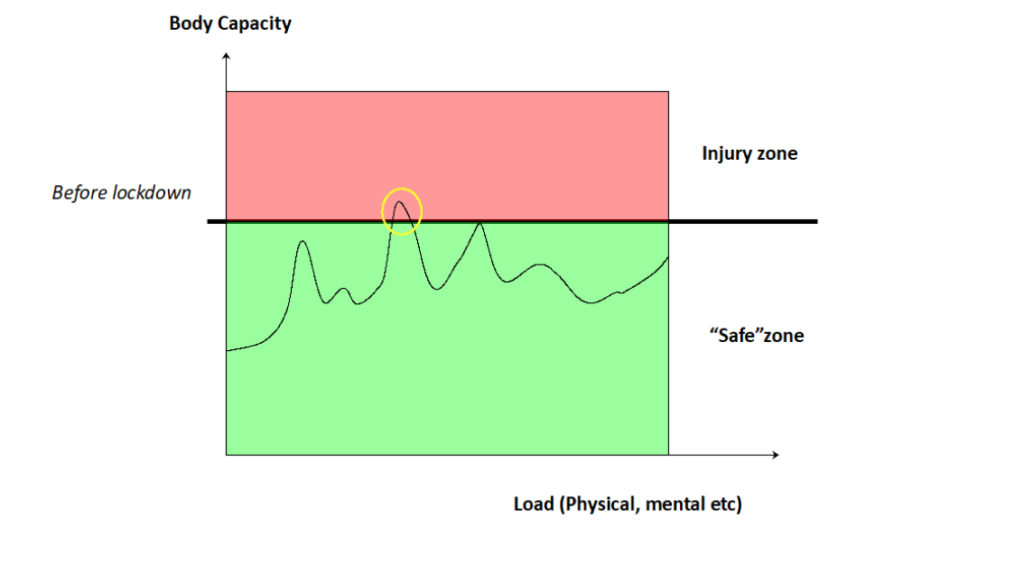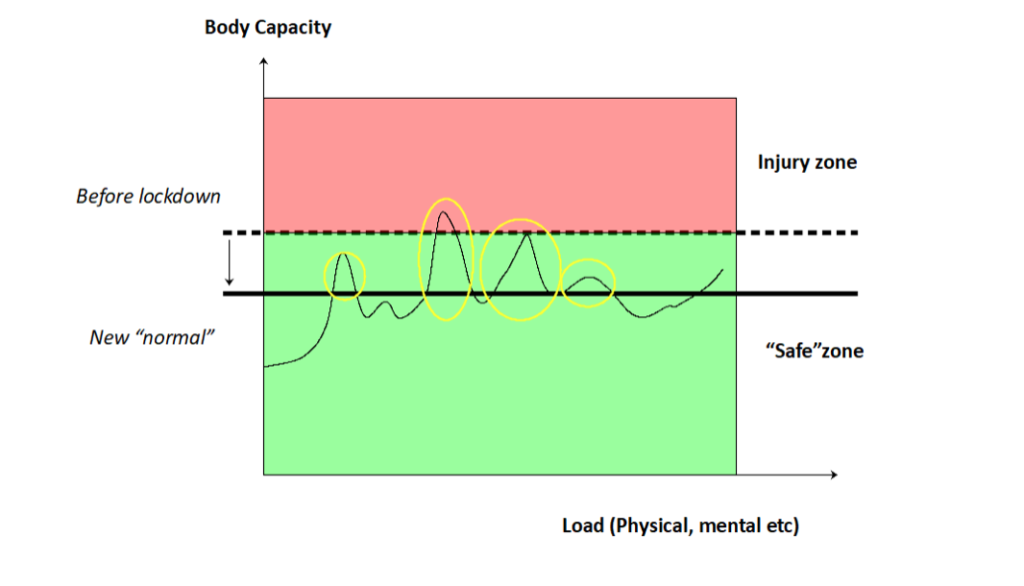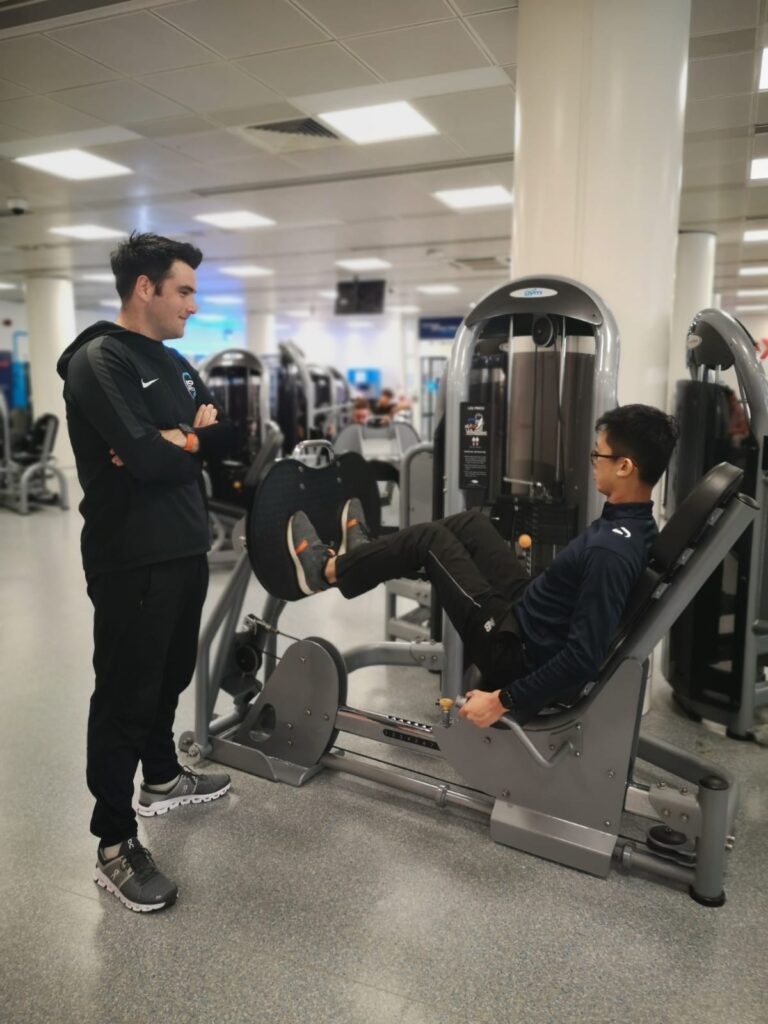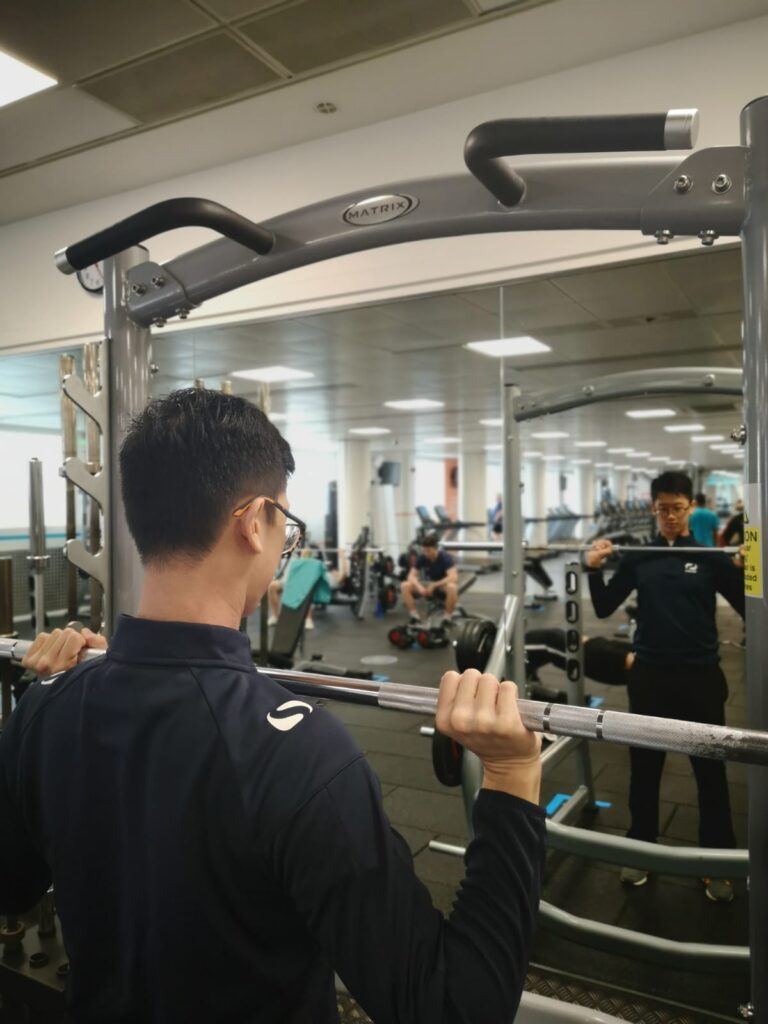
Date Published: September 2, 2020
Its been a while since many of us last stepped in a gym. Hopefully, everyone has been able to adapt and find new ways to keep training towards your goals. With the gyms re-opening this week, I am sure everyone is raring to go. Everyone at ESP Physio enjoys working out in the gym for different reasons so we are just as excited as you are!
At the same time, we anticipate much more injuries in the upcoming week as everyone starts working out again. Thus, this blog will be sharing with you some practical tips which you can use for your own workouts to keep yourself injury-free.
When do injuries occur?
As physiotherapists who work with a diverse group of patients (rugby players, footballers, powerlifters, strongmen athletes, crossfittters, regular gym-goers … you get the point!), we have seen all sorts of injuries from working out in the gym. It gets complicated and even controversial if we dive into the hows and whys of injuries. But the general principle is actually pretty straightforward.
Have a look at the picture below. Injuries (yellow circle) happen when what you do (load) goes beyond what your body is capable of handling (body capacity).

We can expect a decrease in our body’s capacity from being unable to train during lockdown. Consequently, our odds of injuries increases (yellow circles) even though we might be doing the same workouts before lockdown!

Thus, it is important more than ever to know what to do (or not do) to keep yourself injury-free. In the context of gym workouts, injuries usually happens in one of these ways.
| Loading too quickly | Too much too soon (i.e. Starting with too high a load, increasing weights too quickly) |
| Not doing enough general physical preparation work | Too little too late (i.e. Aiming for a 50% increase in 1 RM with 8 weeks to a competition) |
| Insufficient sleep or nutrition | Leading to body being under-prepared and under-recovered |
| Lack of body maintainance | Not warming up/cooling down, lack of tissue care such as mobility/stretching outside of workouts |
| Poor technique or form | Most often related to one of the above reasons |

Here are our top 5 tips for returning to training injury-free
1. Start low, go slow.
We know its extremely tempting to pick up from you left off before lockdown. That is the classic recipe for an injury – Too much too soon! Take into account that you are probably deconditioned from not lifting the past few months.
Instead, we recommend to start at 50% of your previous weights. Keep the reps and sets largely the same, assuming its some variation of the usual 3x10s, 5x5s, 8x3s or other similar programs.
Example:
Before Lockdown Squats @ 150kg, 5 sets x 5 reps
After Re-opening Squats @ 75kg. 5 sets x 5 reps
*This is extrapolating based on previous research showing varying levels of strength loss between 16-40% in a 10-16 week period (McMaster, Gill, Cronin, & McGuigan, 2013)
How much to progress?
It is also important to resist the temptation to progress too quickly! Aim to progressively increase your weight by 10-15% weekly (assuming you train 2-3x weekly).
Example: ~10 % increase in weights
Week 1 Squats @ 75 kg, 5 sets x 5 reps
Week 2 Squats @ 82.5 kg, 5 sets x 5 reps
Week 3 Squats @ 90 kg, 5 sets x 5 reps
Alternatively, you can consider increasing the total number of reps completed instead.This helps to improve your body’s overall capacity to handle loads – Think of it as building a strong foundation for your house!
Example: (~ 10% increase in reps)
Week 1 Squats @ 75kg, 5 sets x 5 reps, total reps 24
Week 2 squats @ 75kg, 7 sets x 4 reps, total reps 28
Week 3 squats @ 75kg, 6 sets x 5 reps, total reps 30
Either way, be sure to only progress one thing at time. Avoid progressing both weights and reps at the same time.
2. Focus on technique and form
A common issue we often see – People with poor form or technique that does not get corrected early on going onto cause injuries when trying to progress.
This happens because the human body is incredibly resilient and can adapt to whats thrown at it. But with lifting heavier weights, it comes to a point where the body just cannot compensate any further!
After this long break, these movements might just feel unfamiliar and odds are, it will not be ideal. Good form are like good habits, it takes time to build but its easy to lose; we all know how easy it is for bad habits to form!
Take this opportunity to work on good form and your body will thank you in the future!
3. Exercises you should (and shouldn’t) be doing
The unfortunate truth with our bodies – Use it or lose it. Strength is the obvious thing this applies to, but don’t forget mobility as well.
You cannot expect to have sufficient ankle mobility for squatting when you have been sitting on your butt the past months working from home!
Its a good idea to spend time preparing your body by warming up. A good warm-up should include a way to get your heart rate up along with mobility drills depending on what you plan to do in a session.
*We will be posting some of our favourite warm ups on our social media soon (read to the end for the links!)
Similarly, there are some exercises you would want to avoid when just starting again.
- Plyometrics
- Jumps, hops, bounding type exercises
- Maximum strength workouts
- Training at more than 85% 1RM
- Speed workouts
- Maximum sprints or similar
The reason being these exercises place a much higher demand on your tissues (muscles and tendons). Strength improvements early in the workout is usually due to improve efficiency of muscle performance. Muscle and tendons usually take abit longer to physicall grow. Tus, we suggest to give yourself about 8-12 weeks before starting these workouts again (Hughes, Ellefsen & Baar, 2017).
*Assuming you have not done any of these during the break. If you have, then you can consider easing into it but take note that you are loading more with gym-work.
4. Monitor your intensity
So far, we have been discussing the technical elements of a workout. So here’s one thing while working out to keep in mind – moderation.
Keep each set to a moderate intensity. This is roughly a 4-7/10 on a 1-to-10 scale (also known as the RPE scale, 1 being effortless and 10 being exhausted). Avoid pushing each set to failure as the risk of injuries increases when you do that.
Another easy way to estimate this the reps-in-reserve (RIR) method. At then end of each set, estimate how many reps you are able to do till failure. Aim to have at least 3 more reps in the tank, or 3/3+RIR (See below).
3+ RIR (or RPE < 7) = More than 3 Reps In Reserve = more than 3 repetitions away from failure
3 RIR (or RPE 7) = 3 Reps In Reserve = 3 repetitions away from failure
2 RIR (or RPE 8) = 2 Reps In Reserve = 2 repetitions away from failure
1 RIR (or RPE 9) = 1 Rep In Reserve = 1 repetitions away from failure
0 RIR (or RPE 10) = 0 Reps In Reserve = 0 repetitions away from failure/max effort
Choose one method that you are comfortable with. This information can be used to monitor yourself to ensure you aren’t over-reaching.
5. Eat, Sleep and Drink
No, we are not saying to turn into a sloth. But recovery is essential to both making gains and reducing your risk of injuries.
Some ways you can help your body to recover include:
- 24-48 hours rest between sessions
- 8 hours sleep daily
- Drink sufficient fluids – drink up if you feel thirsty
- Consume sufficient nutrients – i.e Post-workout meals/shakes, regular meals
(Allencar and Valle, 2019; Grønli, Soulé & Bramham, 2014)
*The figures recommended in this blog is based on the likelihood that it will be suitable for the majority of people reading this. For those who are more experienced or if you are training with a personal trainer/coach, feel free to change this up – just remember the underlying principle stays the same.

That was too lengthy? Here’s a summary!
Start low, go slow. Prepare to train, recover to gain.
- Start at 50% of pre-lockdown weights and build up gradually.
- Focus on form and technique
- Do your warm-ups and mobility work and avoid explosive exercises (such as plyometrics)
- Every set in moderation (RPE 4-7/10 or 3+ RIR)
- Eat, drink and sleep well
Bonus tip for those of you who made it to the end!
Its often helpful to speak to a healthcare professional if you have an injury thats not resolving, or if you experience any niggles that’s bother you. It can be difficult to pinpoint the cause of the problem and even more so to know what to do to fix it. Save yourself the trouble by getting yourself seen instead!
All of our physiotherapists at ESP are fully qualified healthcare professionals registered with the HCPC and CSP. We perform a thorough assessment at your first visit to diagnose your injury. You can expect a bespoke treatment plan in the form hands-on treatment combined with exercise and training input; all from your very first session!
For the fortunate ones who are injury-free, we also offer a no-frills sport massage if you just require some relief with a stiff neck or sore back.
Give us a call at 01324 227 370 or drop us an email at info@espphysio.com if you are wanting to speak to us about this blog or your injury!
Follow us on our social media pages (instagram, facebook) for weekly exercise videos and updates on future blogs!
References
Grønli, J., Soulé, J., & Bramham, C. R. (2014). Sleep and protein synthesis-dependent synaptic plasticity: impacts of sleep loss and stress. Frontiers in behavioral neuroscience, 7, 224.
Hughes, D. C., Ellefsen, S., & Baar, K. (2017). Adaptations to Endurance and Strength Training. Cold Spring Harbor Perspectives in Medicine, 8(6), a029769. doi:10.1101/cshperspect.a029769
Allencar, M. and Valle, J., 2019. A Road Map To Effective Muscle Recovery. [ebook] ACSM. Available at: <https://www.acsm.org/docs/default-source/files-for-resource-library/a-road-map-to-effective-muscle-recovery.pdf?sfvrsn=a4f24f46_2> [Accessed 31 August 2020].
McMaster, D. T., Gill, N., Cronin, J., & McGuigan, M. (2013). The Development, Retention and Decay Rates of Strength and Power in Elite Rugby Union, Rugby League and American Football. Sports Medicine, 43(5), 367–384. doi:10.1007/s40279-013-0031-3
Blog written by Andrew Linn
Share This Article:

